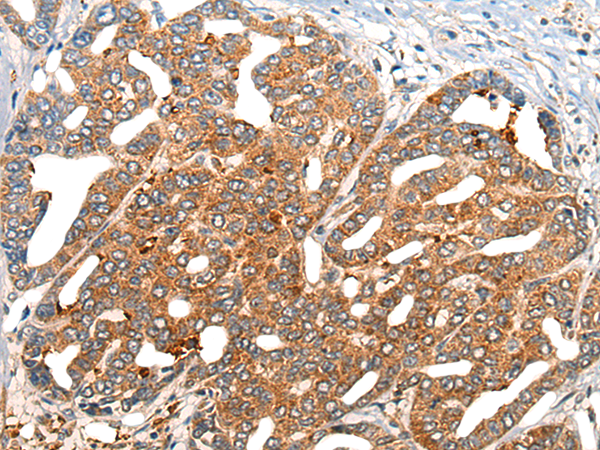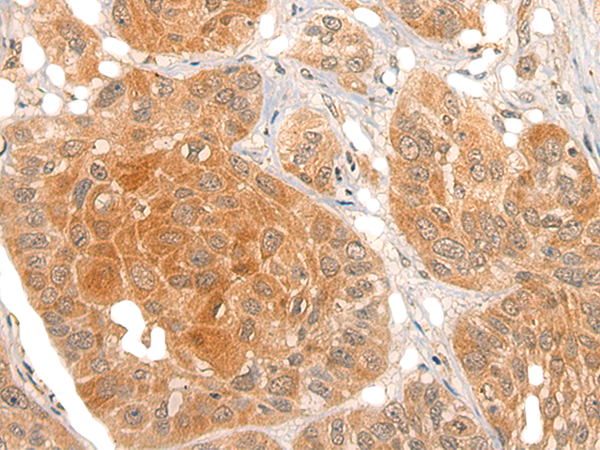

| WB | 咨询技术 | Human,Mouse,Rat |
| IF | 咨询技术 | Human,Mouse,Rat |
| IHC | 1/30-1/150 | Human,Mouse,Rat |
| ICC | 技术咨询 | Human,Mouse,Rat |
| FCM | 咨询技术 | Human,Mouse,Rat |
| Elisa | 1/5000-1/10000 | Human,Mouse,Rat |
| Aliases | SYM1; SYNS1; SYNS1A |
| Host/Isotype | Rabbit IgG |
| Antibody Type | Primary antibody |
| Storage | Store at 4°C short term. Aliquot and store at -20°C long term. Avoid freeze/thaw cycles. |
| Species Reactivity | Human, Mouse |
| Immunogen | Synthetic peptide of human NOG |
| Formulation | Purified antibody in PBS with 0.05% sodium azide and 50% glycerol. |
+ +
以下是关于NOG(Noggin)抗体的3篇参考文献及其摘要内容:
---
1. **文献名称**: *"Noggin-mediated antagonism of BMP signaling is required for growth and patterning of the neural tube and somite"*
**作者**: McMahon, J.A., et al.
**摘要**: 该研究通过免疫组化和抗体标记技术,揭示了Noggin蛋白在胚胎发育中通过拮抗BMP信号通路调控神经管和体节的形成。研究发现,NOG抗体可特异性识别并阻断Noggin功能,从而影响背侧神经管的分化。
---
2. **文献名称**: *"Identification of a potent natural bone morphogenetic protein inhibitor: Noggin protein purification and characterization"*
**作者**: Zimmerman, L.B., et al.
**摘要**: 本文报道了Noggin蛋白的纯化方法及其抗体的开发,验证了抗体在Western blot和免疫荧光中的特异性。研究通过抗体阻断实验证实,Noggin通过抑制BMP信号通路调控骨骼发育。
---
3. **文献名称**: *"Structural basis of BMP signalling inhibition by Noggin: Insights from X-ray crystallography"*
**作者**: Groppe, J.C., et al.
**摘要**: 通过X射线晶体学解析Noggin与BMP结合的分子结构,研究利用特异性NOG抗体验证了Noggin与BMP的相互作用位点,揭示了其在抑制骨形成中的分子机制,为治疗骨骼疾病提供理论依据。
---
如需具体文献链接或扩展研究领域(如癌症、再生医学等),可进一步补充说明。
Noggin (NOG) antibodies are immunological tools used to detect and study the function of Noggin, a secreted glycoprotein crucial in embryonic development. Discovered in the early 1990s, Noggin acts as a key antagonist of bone morphogenetic proteins (BMPs), particularly BMP-4. by binding to them and preventing receptor activation. This inhibition is vital for neural induction, skeletal formation, and joint development. Dysregulation of Noggin has been implicated in developmental disorders, skeletal abnormalities, and certain cancers.
NOG antibodies are widely utilized in developmental biology and biomedical research to visualize Noggin expression patterns, quantify protein levels, or block its activity in experimental models. They enable investigations into Noggin's role in stem cell differentiation, tissue homeostasis, and disease mechanisms. For instance, studies using NOG antibodies have revealed its neuroprotective effects and regulatory functions in cartilage maintenance. Clinically, Noggin overexpression is associated with conditions like fibrodysplasia ossificans progressiva (FOP), while its suppression may contribute to tumor progression.
These antibodies are available in monoclonal or polyclonal forms, often validated for applications including Western blot, immunohistochemistry, and ELISA. Recent therapeutic strategies also explore Noggin-targeting antibodies to modulate BMP signaling pathways in regenerative medicine or cancer therapy. Research continues to refine antibody specificity and explore clinical translations, underscoring Noggin's multifaceted biological significance.
×